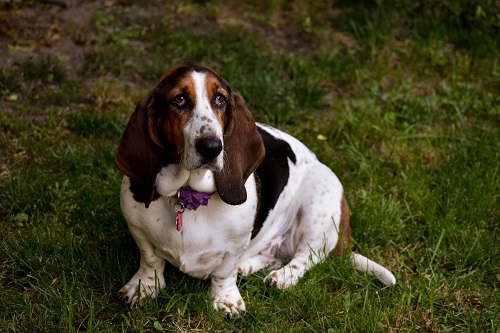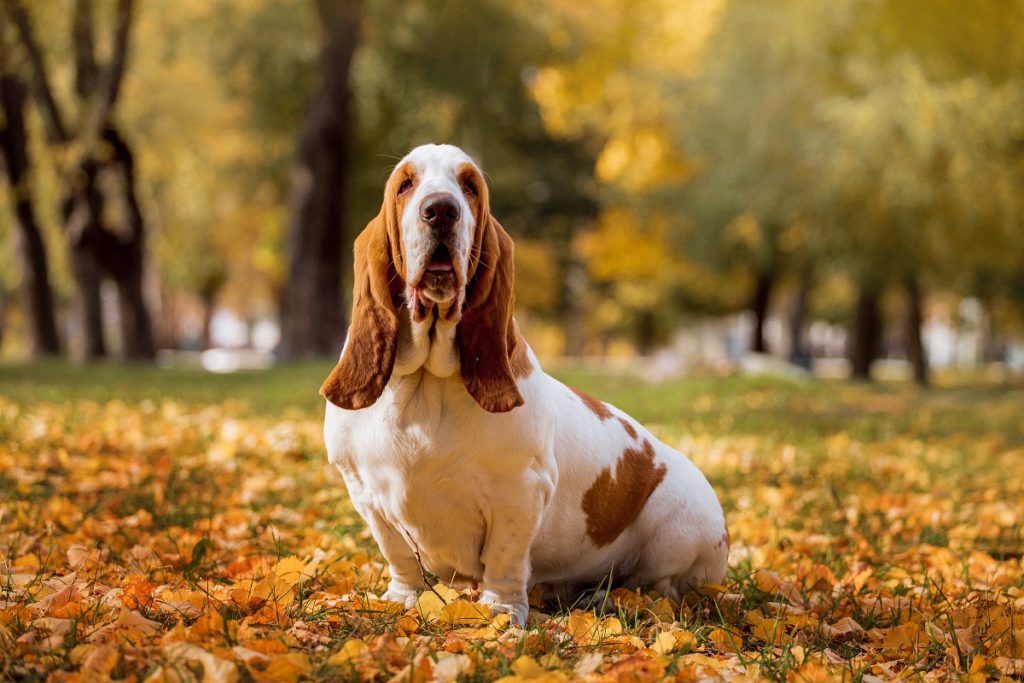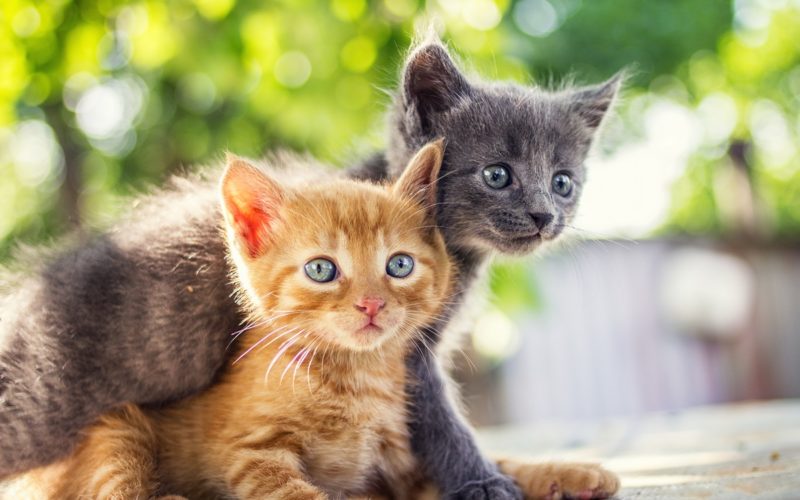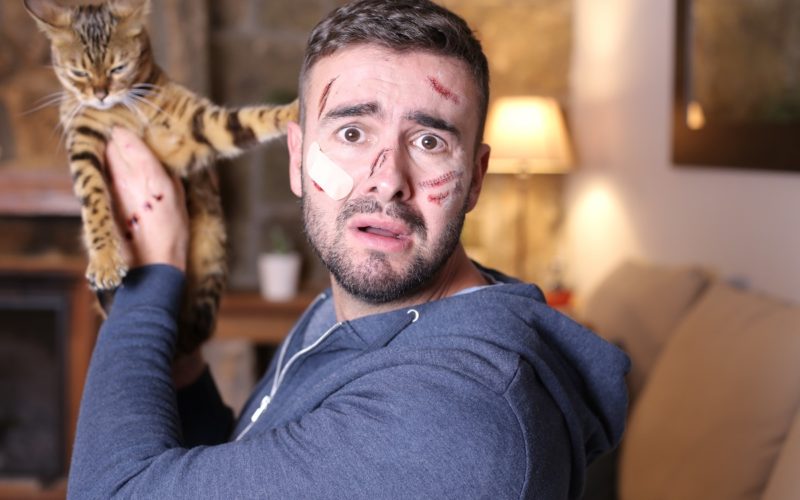The Basset Hound is a visually distinct breed, immortalized in the 1970s and 1980s cartoons as the languid-speaking “Droopy Dog”. At a glance, it’s easy to see that this beautiful black, white, and brown dog is bred for hunting: his resemblance to a Bloodhound is unmistakable. The two are closely genetically related, with the basset being, ironically, slightly less “droopy” than their similar-breed hunting cousin.
Basset Hounds are characterized by short, stubby legs – which is actually at the root of their name, originating from the French word ‘bas’ (which translates to “short in stature”). Their floppy ears hang low or at the ground, and they have a dewlap – a fold of skin just below their chin on the front of their neck. These three traits combine into an efficient “scent funnel” that guides whatever smells they are tracking on the ground directly to their sensitive nose, blocking out environmental distractions. For this reason, this breed is second only to Bloodhound in terms of tracking down prey on a hunt or individuals and areas of interest in police work and drug detection.
Basset Hound Temperament & Personality
When it comes to the basset hound personality, they tend to be easy-going, calm, and affectionate towards their owners. Because they are used to working in packs, they normally work very well with other dogs or household pets. Since they have such a friendly and tranquil demeanor, this breed is a great option for families with children as well. When it comes to training, these dogs tend to have a stubborn streak that can be hard to break. Owners should be consistent with their training efforts and use positive reinforcement to encourage good behavior.
Basset Hounds & Home Life: A Useful Guide
In no small part owing to their short legs, mobility around the home is at least a passing consideration for Basset Hound pet parents. Particularly steep steps or tall furniture can be a challenge (or a convenient barrier, depending on the desired outcome) to a Basset’s  free movement around the home. Particularly dusty or muddy yards can also pose issues with his level of cleanliness – when a Basset trudges out into a damp yard, it isn’t only his paws getting wet and dirty, it’s his entire underside.
free movement around the home. Particularly dusty or muddy yards can also pose issues with his level of cleanliness – when a Basset trudges out into a damp yard, it isn’t only his paws getting wet and dirty, it’s his entire underside.
That’s why baths are a weekly necessity for a Basset, lest he leaves dirty paw prints on every carpet in his wake. “Doing his business” in the rain can be particularly taxing on his owners, as they’ll need to towel him off thoroughly before bringing him back in.
As he ages, an ergonomic or memory foam pet bed on the floor will help ease any joint pain or strain, and likely make it easier for him to rest comfortably. These dogs are, however, notorious droolers! Their humans should be prepared to clean up drool both from the dog himself, as well as his environment, from time to time.
Basset Hound Health Issues: What Pet Parents Should Know?
Bassets are uniquely built among dog breeds, with a short, sturdy bone structure and a thick, close-cropped coat; these features allow them to pursue prey through dense underbrush without getting scratched. The same bone structure, however, makes them susceptible to back and hip problems later in life, which is why they aren’t necessarily a good canine companion for children. Kids
may roughhouse with a basset or put stress on his back, which aggravates existing bone structure issues.
Because of his exaggerated “droopy” features, a Basset Hound may experience canine skin rashes and bacterial infections where his skin folds over on itself. One of the most notable problem areas is in the ear: the long flapped ear doesn’t air out well, which can lead to an infection. A Basset’s pet parent(s) will need to thoroughly clean his ears with vet-approved wipes at least once or twice a week to make sure they stay healthy and remain inhospitable to bacteria.
Eye issues are another common problem in Basset Hounds, due to their large sunken-in eye sockets and surrounding skin folds. They are prone to issues like canine cherry eye and pink eye, as well as generic scratches, injuries, and foreign objects irritating the eye itself.
Basset Hound Grooming: Proper Care For The Breed
Because of his short height, a basset will get more dirt and dust on his underside than other taller dog breeds, and the oily finish of his fur combined with his skin flaps may contribute to his body odor. Basset Hounds, particularly older dogs, may also have dental issues that lead to notoriously bad breath. If a Basset Hound is particularly unpleasant-smelling, his owners may want to speak to a vet about grooming frequency and diet changes to prevent the bacteria causing the issue.
Diligent nail trimming is extremely important for a Basset Hound, as his stocky body is balanced entirely on wide-set paws. A twisted or injured nail can cause him a great deal of pain, as can nails that are too long to comfortably stand on. If he tolerates it well, his pet parent can use a pet nail grinding tool to keep them at a manageable length or defer to a professional groomer for help if he has trouble sitting still.
Steadfast & True: Is A Basset Hound For You?
A Basset Hound is a hunting, sniffing, canine superstar that may be short in stature, but is big in proverbial heart. Even if rabbit-hunting never appears on a home’s weekly schedule, this doe-eyed dog makes an excellent, loving addition to an adult household.
Sources Cited:
- “Basset Hound.” DogTime.com, (no publish date), https://dogtime.com/dog-breeds/basset-hound. Accessed September 23, 2019.
- OConnell, Rebecca. “9 Floppy Facts About Bassett Hounds.” Mental Floss.com, November 30, 2015, http://mentalfloss.com/article/71703/9-floppy-facts-about-basset-hounds. Accessed September 23, 2019.
- Turner, Josie F. “What Are the Best Breeds of Police Dogs?” Animal Wised.com, January 19, 2017, https://www.animalwised.com/what-are-the-best-breeds-of-police-dogs-463.html. Accessed September 23, 2019.





